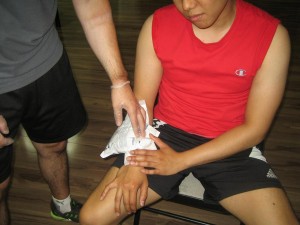The hands are the frequently used parts of the body and the fingers are prone to exposure to hot surfaces such as hot pans, hot burner, blistering steam and an open flame. Accidentally touching or holding these surfaces can result to a burn and blisters. There are three types of burn – 1st, 2nd and 3rd degree burns.
[youtube url=”https://www.youtube.com/watch?v=pwRCn_lkxeQ” width=”220″]There are ways that a person can sustain these burns such as direct contact with hot surface such as hot tar, metal, an iron and a stove. Chemical burns are caused by strong acids or hydrochloric acids, disinfectants and lye. A scald burn is usually due to exposure to hot steam or hot fluids.
In a 1st degree burn, the affected area such as the finger will only look red, inflamed and slightly painful. For a second degree burn or partial thickness burn, the affected area becomes red, inflamed, pain and blistering occurs. The blisters that form are due to a burn and the body sends fluid into the area to fill the gap between the layers of the skin to help protect it. As for a third degree burn, the skin becomes blackened and affects the deep layers of the skin and this condition requires medical help immediately.
Treatment of a blistering burn

- Remove immediately the affected area of the body from the source of heat in order to help prevent the condition from getting worse.
- Rinse the affected finger using cool and running water for at least 5 minutes. The cold helps in constricting the blood vessel and help lessen the amount of fluids lost in burnt area. It also helps in preventing damage to the tissue and minimizes the pain. Another way is soaking the finger in a basin with cold water to minimize pain and swelling for at least 15-20 minutes until the pain lessens.
- Let the fingers dry in the air and avoid drying it with a towel since it can cause severe pain.
- Apply an ointment such as Vaseline so that the affected area will not stick with the bandage.
- Apply the prescribed sulfadiazine cream on the burned area in order to prevent any infection and for fast healing of the affected area by eliminating and preventing the growth of bacteria. Dab the cream at once or twice every day
- If the blisters on the affected area has broken open, cover it using a sterile dressing at least two layers in order to reduce the risk for infection. If the blisters do not pop up, there is no need to cover it with a dressing.
- Take the prescribed pain medications such as paracetamol, ibuprofen or aspirin in order to help lessen pain.
FACT CHECK
https://www.healthline.com/health/burned-finger
https://www.healthline.com/health/home-remedies-for-burns
https://www.webmd.com/first-aid/thermal-heat-or-fire-burns-treatment#1
